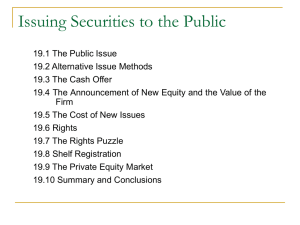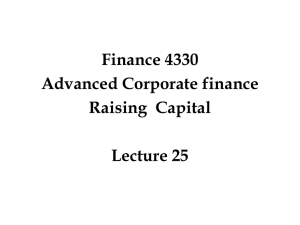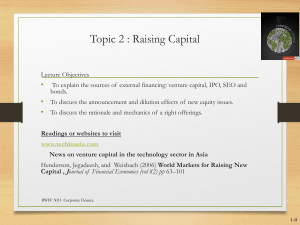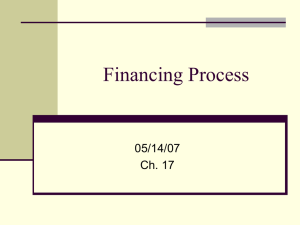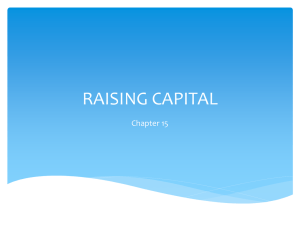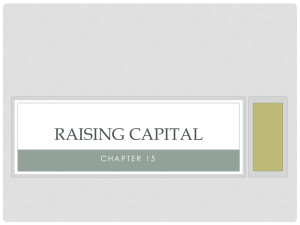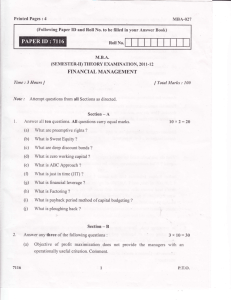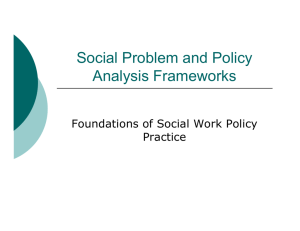Issuing Securities to the Public
advertisement
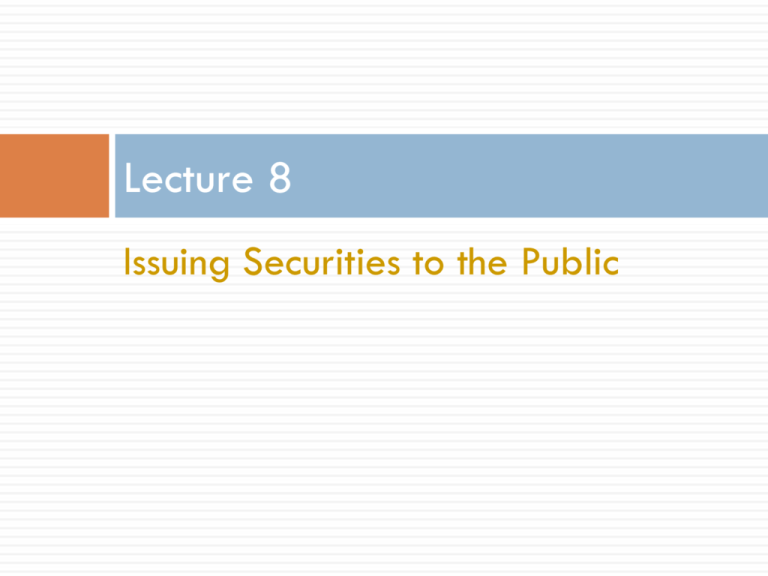
Lecture 8 Issuing Securities to the Public Issuing Securities to the Public The Public Issue vs The Private Issue Alternative Issue Methods The Cash Offer New Equity and the Value of the Firm The Cost of New Issues Rights Shelf Registration The Private Equity Market The Public Issue 증권의 공개매각 The Basic Procedure Management gets the approval of the Board of Directors. The firm prepares and files a registration statement with the SEC. 등록신청서, 증권거래위원회 The SEC studies the registration statement during the waiting period. 20일의 대기기간 red If herring ( 임시 투자설명서) 배포 everything is copasetic with the SEC, a price is set and a full-fledged selling effort gets underway. The Process of A Public Offering Steps in Public Offering 1. Pre-underwriting conferences 2. Registration statements 3. Pricing the issue 4. Public offering and sale 5. Market stabilization Time Several months 20-day waiting period Usually on the 20th day After the 20th day 30 days after offering 대기기간 중에는 증권을 매각할 수 없다. 증권의 가격은 등록이 효력을 가지게 되는 날 결정된다 Tombstone Advertisement Example 증권의 인수회사 인수회사가 제공하는 서비스 신규증권의 발행방법을 제시한다. 신규증권의 가격을 책정한다. 신규증권을 판매한다. 대표인수회사에 의한 주가의 안정화 인수연합(syndicate) – 증권을 매각하고 매각에 따른 위험을 분담할 수 있도록 증권인수회사들이 형성한 연합 총차액( gross spread) – 발행회사에게 인수회사가 지불하는 가격(인수회사의 매수가격)과 시장에서 판매할 때의 가격(발행가격; offering price)과의 차이 16-6 Alternative Issue Methods There are two kinds of public issues: Negotiated vs direct cash offer The general cash offer Nontraditional Shelf The cash offer . Stand-by offer rights offer Privileged subscription or Rights offer Almost all debt is sold in general cash offerings. Direct placement The Cash Offer 현금발행 There are two methods for issuing securities for cash: Firm Commitment Best Efforts Dutch auction cash offer There are two methods for selecting an underwriter Competitive Negotiated Firm Commitment Under a firm commitment underwriting, the investment bank buys the securities outright from the issuing firm. Obviously, they need to make a profit, so they buy at “wholesale” and try to resell at “retail”. To minimize their risk, the investment bankers combine to form an underwriting syndicate to share the risk and help sell the issue to the public. Best Efforts Under a best efforts underwriting, the underwriter does not buy the issue from the issuing firm. Instead, the underwriter acts as an agent, receiving a commission for each share sold, and using its “best efforts” to sell the entire issue. This is more common for initial public offerings than for seasoned new issues. The Announcement of New Equity and the Value of the Firm The market value of existing equity drops on the announcement of a new issue of common stock. Reasons include Managerial Information Since the managers are the insiders, perhaps they are selling new stock because they think it is overpriced. Debt Capacity If the market infers that the managers are issuing new equity to reduce their debt-equity ratio due to the specter of financial distress the stock price will fall. Falling Earnings The Cost of New Issues 1. 2. 3. 4. 5. 6. Spread or underwriting discount Other direct expenses Indirect expenses Abnormal returns Underpricing Green Shoe Option The Costs of Public Offerings Proceeds (in millions) 2 - 9.99 10 - 19.99 20 - 39.99 40 - 59.99 60 - 79.99 80 - 99.99 100 - 199.99 200 - 499.99 500 and up Equity Direct Costs SEOs IPOs 13.28% 16.96% 8.72% 11.63% 6.93% 9.70% 5.87% 8.72% 5.18% 8.20% 4.73% 7.91% 4.22% 7.06% 3.47% 6.53% 3.15% 5.72% Underpricing IPOs 16.36% 9.65% 12.48% 13.65% 11.31% 8.91% 7.16% 5.70% 7.53% Rights 주주모집 If a preemptive right is contained in the firm’s articles of incorporation, the firm must offer any new issue of common stock first to existing shareholders. This allows shareholders to maintain their percentage ownership if they so desire. Mechanics of Rights Offerings The management of the firm must decide: The exercise price (the price existing shareholders must pay for new shares). How many rights will be required to purchase one new share of stock. These rights have value: Shareholders rights. can either exercise their rights or sell their Rights Offering Example Popular Delusions, Inc. is proposing a rights offering. There are 200,000 shares outstanding trading at $25 each. There will be 10,000 new shares issued at a $20 subscription price. What is the new market value of the firm? What is the ex-rights price? What is the value of a right? What is the new market value of the firm? $25 $20 $5,200,000 200,000 shares 10,000 shares share shares There are 200,000 outstanding shares at $25 each. There will be 10,000 new shares issued at a $20 subscription price. What is the Ex-Rights Price? There are 110,000 outstanding shares of a firm with a market value of $5,200,000. Thus the value of an ex-rights share is: $5,200,000 = $24.7619 210,000 shares Ex-Rights Price? Thus the value of a right is $0.2381 = $25 – $24.7619 The Rights Puzzle Over 90% of new issues are underwritten, even though rights offerings are much cheaper. A few explanations: Underwriters increase the stock price. There is not much evidence for this, but it sounds good. The underwriter provides a form of insurance to the issuing firm in a firm-commitment underwriting. The proceeds from underwriting may be available sooner than the proceeds from a rights offering. No one explanation is entirely convincing. Shelf Registration 일괄등록제도 Permits a corporation to register an offering that it reasonably expects to sell within the next two years. Not all companies are allowed shelf registration. Qualifications include: The firm must be rated investment grade. The cannot have recently defaulted on debt. The market capitalization must be > $75 m. No recent SEC violations. The Private Equity Market The previous sections of this chapter assumed that a company is big enough, successful enough, and old enough to raise capital in the public equity market. For start-up firms and firms in financial trouble, the public equity market is often not available. Private Placements Avoid the costly procedures associated with the registration requirements that are a part of public issues. The SEC restricts private placement issues ot no more than a couple of dozen knowledgeable investors including institutions such as insurance companies and pension funds. The biggest drawback is that the securities cannot be easily resold. Venture Capital The limited partnership is the dominant form of intermediation in this market. There are four types of suppliers of venture capital: 1. 2. 3. 4. Old-line wealthy families. Private partnerships and corporations. Large industrial or financial corporations have established venture-capital subsidiaries. Individuals, typically with incomes in excess of $100,000 and newt worth over $1,000,000. Often these “angels” have substantial business experience Corporate Equity Security Offerings 17.7 16.2 66.1 Private Rule 144A placements Private non-Rule 144A placements Public equity offering Stages of Financing 1. Seed-Money Stage: Small amount of money to prove a concept or develop a product. 2. Start-Up Funds are likely to pay for marketing and product refinement. 3. First-Round Financing Additional money to begin sales and manufacturing. 4. Second-Round Financing Funds earmarked for working capital for a firm that is currently selling its product but still losing money. 5. Third-Round Financing Financing for a firm that is at least breaking even and contemplating expansion; a.k.a. mezzanine financing. 6. Fourth-Round Financing Financing for a firm that is likely to go public within 6 months; a.k.a. bridge financing.
